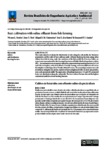Please use this identifier to cite or link to this item:
http://www.alice.cnptia.embrapa.br/alice/handle/doc/1045123Full metadata record
| DC Field | Value | Language |
|---|---|---|
| dc.contributor.author | SIMOES, W. L. | pt_BR |
| dc.contributor.author | YURI, J. E. | pt_BR |
| dc.contributor.author | GUIMARÃES, M. J. M. | pt_BR |
| dc.contributor.author | SANTOS, J. E. dos | pt_BR |
| dc.contributor.author | ARAÚJO, E. F. J. | pt_BR |
| dc.date.accessioned | 2016-05-16T11:11:11Z | pt_BR |
| dc.date.available | 2016-05-16T11:11:11Z | pt_BR |
| dc.date.created | 2016-05-16 | pt_BR |
| dc.date.issued | 2016 | pt_BR |
| dc.identifier.citation | Revista Brasileira de Engenharia Agrícola e Ambiental, v. 20, n. 1, p. 61-66, 2016. | pt_BR |
| dc.identifier.uri | http://www.alice.cnptia.embrapa.br/alice/handle/doc/1045123 | pt_BR |
| dc.description | This study aimed to evaluate the distribution of salts along the soil profile, the biometric parameters and the yield of beet cultivars under different leaching fractions using saline effluent from fish farming, under the conditions of the Sub-middle São Francisco Valley. An experiment was conducted at the Caatinga Experimental Field of the Embrapa Semi-Arid, in 2013. The treatments were arranged in split plots composed of four leaching fractions (0, 5, 10 and 15%) in the plots, with saline effluent from fish farming, and three table beet cultivars in the subplots: Scarlet Super, Early Wonder 200 and Fortuna. The analysed parameters were: salt distribution along the soil profile, number of leaves, length and width of leaves and petioles, total and commercial yields. The application of leaching fractions of 10 and 15% promoted better salt distribution along the soil profile. The beet cultivar Fortuna showed the highest commercial yield for a lower leaching fraction. | pt_BR |
| dc.language.iso | por | pt_BR |
| dc.rights | openAccess | pt_BR |
| dc.subject | Fração de lixiviação | pt_BR |
| dc.title | Beet cultivation with saline effluent from fish farming. | pt_BR |
| dc.type | Artigo de periódico | pt_BR |
| dc.date.updated | 2017-01-26T11:11:11Z | pt_BR |
| dc.subject.thesagro | Beterraba | pt_BR |
| dc.subject.thesagro | Salinidade | pt_BR |
| dc.subject.thesagro | Água Salina | pt_BR |
| dc.subject.thesagro | Lixiviação | pt_BR |
| dc.subject.nalthesaurus | Water salinity | pt_BR |
| dc.subject.nalthesaurus | Beets | pt_BR |
| riaa.ainfo.id | 1045123 | pt_BR |
| riaa.ainfo.lastupdate | 2017-01-26 | pt_BR |
| dc.identifier.doi | 10.1590/1807-1929/agriambi.v20n1p62-66 | pt_BR |
| dc.contributor.institution | WELSON LIMA SIMOES, CPATSA | pt_BR |
| dc.contributor.institution | JONY EISHI YURI, CPATSA | por |
| dc.contributor.institution | MIGUEL J. M. GUIMARÃES, UNIVERSIDADE FEDERAL RURAL DE PERNAMBUCO | por |
| dc.contributor.institution | JOSÉ E. DOS SANTOS, UNIVERSIDADE DE PERNAMBUCO | por |
| dc.contributor.institution | EMANOEL F. J. ARAÚJO, UNIVERSIDADE DE PERNAMBUCO. | por |
| Appears in Collections: | Artigo em periódico indexado (CPATSA)  | |
Files in This Item:
| File | Description | Size | Format | |
|---|---|---|---|---|
| Welson20163.pdf | 1.68 MB | Adobe PDF |  View/Open |









